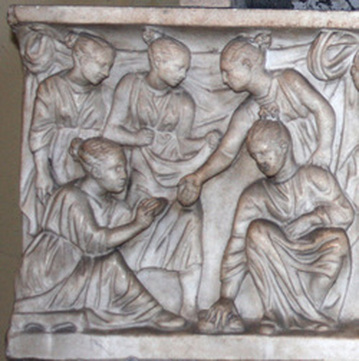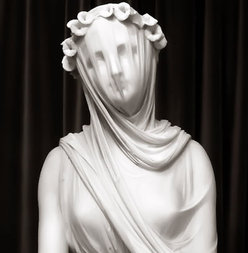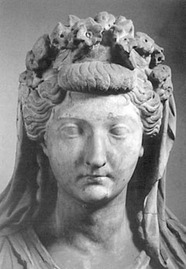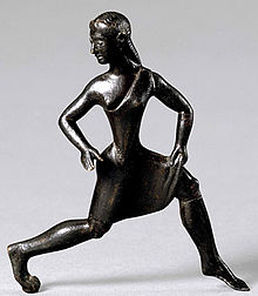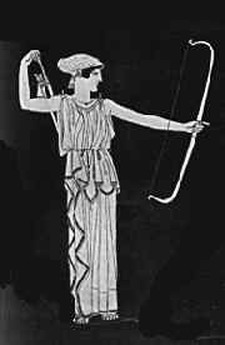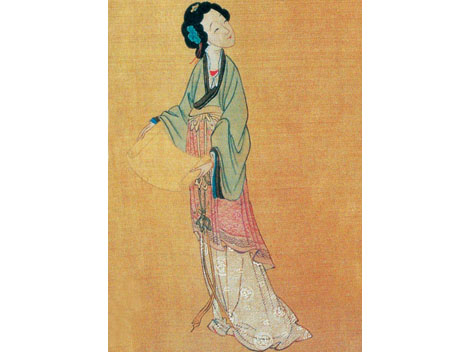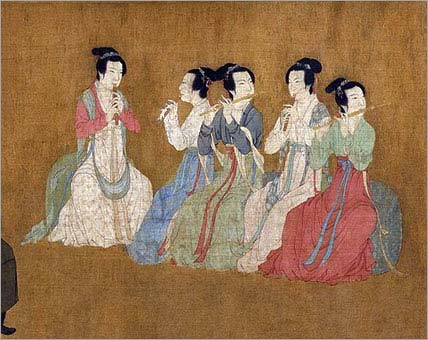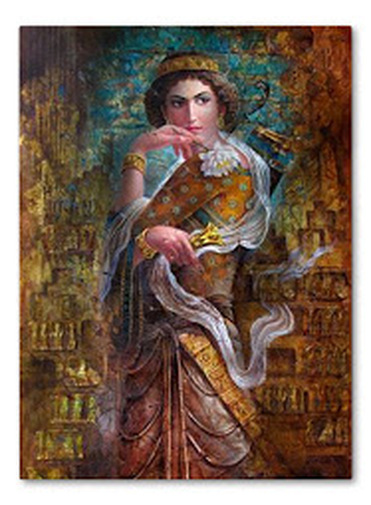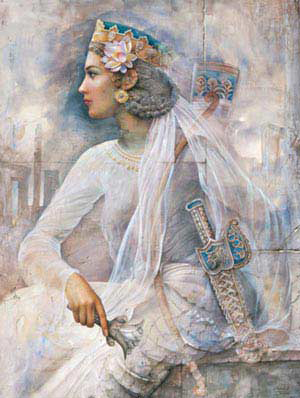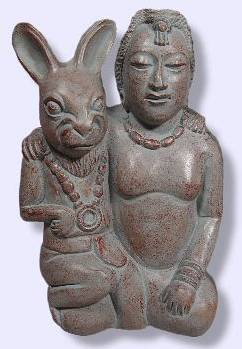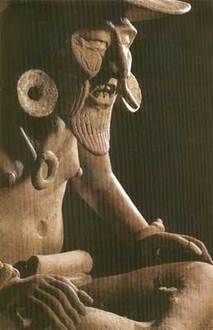Patriarchy in Shaping Gender and Family Relationships
RomeWithin the Roman civilization, women played a large role in helping shape their family life, businesses, religious rituals and even politics. Although during this time period women were considered inferior to men, they still held a great influence on their family. It was custom that Roman women would marry and bear children. Once the children were born, the wives held authority over them and were responsible for raising them to be well-educated and good citizens of Rome. For a Roman woman to really succeed in teaching her children all that they needed to know, the mother needed to be well-educated herself. With this being said, it was procedure that the boys would attend school, but it was not uncommon for girls to attend a public primary school. Along with schooling as an education, both boys and girls went to dinner parties and religious festivals to learn appropriate social behaviors. Not only did the wife play a large role in the family realm, but Roman women could also own property which allowed them to enter the business world because they could trade and sell land. It was not unusual during this time if wives supervised a family business or estate. Some women even completely ran businesses by themselves, although this usually was because they were widowed. Although at this time women could not hold political office or vote, elite Roman women did work behind the scenes and influence the politics through private negotiations. Livia Drusilla Augusta acted several times as a regent and was considered a faithful adviser to Augustus, which shows how women could still influence politics. As for religion, Roman women were considered essential. Although women could not offer animal sacrifices and their participation was limited, women priests played a very important role. The Vestals were a priestly office which only women could hold. These women never married or had children but instead were completely devoted to making sure religious rituals took place correctly, something that was viewed as crucial to Rome's survival. Although it was the men who took part in the public life, women were considered a very important asset to Roman civilization because of the influence they held on religion, home-life, politics and business.
|
---------------------------------------------------------------------------------------------------------------------------------------------------------------------------------------------------------------------------------
Greece: Athens
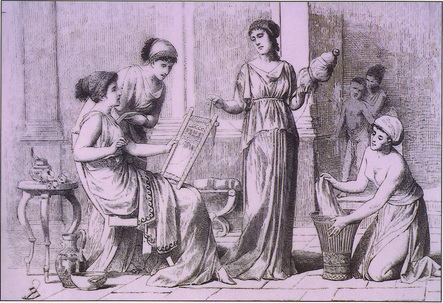
Women were expected to perform household tasks, while men went to social events.
For Athenian women, their rights were drastically limited, and because of this, women had little to no impact on the social life in Athens. Athenian women received a very limited education, and it was one that consisted of learning how to read and facts on religion and mythology. For women living during this time period, their main goal was to marry and bear children. Because of this, girls were taught from a young age how to sew, weave, cook and do other house hold chores. Women in Athens married very young and had absolutely no say in who they would marry because their future husband was chosen by the girl’s father, and the girl would never even meet her soon-to-be husband until her dowry was settled upon. After marriage, girls felt it was their duty to immediately have children. Once a child was born, it was taken to the father who would decide if he wanted to keep it or not, and it was not uncommon for a baby girl to be put in a jar and abandoned at the side of the road. This shows how women were not viewed as an important part of society and could easily be disposed of. Along with men being in charge of what children he would keep and what children he would discard of, men could also easily divorce their wives, while for the wives it was almost impossible to divorce their husband. The men of Athens were also in control of all property and any land that a woman may have owned before marriage was immediately given to her husband following their marriage. By taking away women’s right to own land, it stopped women from being economically independent and forced them to rely on men instead. Along with women relying on men financially, women had no political rights, meaning men were the only ones who could cast votes and take part in the operation of the state. Women also could not go outside without a cause, meaning women were trapped inside all day. For women of the upper class, this meant they had to focus on taking care of their home, children and slaves. For women of the lower class who could not afford slaves, they sometimes had to go outside but only to work in the fields or sell items at the market. Because women were limited on how much time they could spend outside of their homes, most men had a hetaerae who would be his sexual, social, and intellectual companion when he was in a social setting. While Athenian life offered great limitations on what women could and could not take place in, weddings, funerals and state religious festivals were jobs women were expected to handle. The Thesmophoria was a significant religious event that only women could participate in and they were expected to make sacrifices to the goddesses. For women living in Athens during this time, their political, business, and social involvement were greatly limited, and this caused them to have little impact on the society as a whole, but rather to only influence home-life.
Greece: Sparta
For Spartan women, life was considerably different compared to that of Athens. Although men were still viewed as dominant, women of Sparta were much more independent and were able to have some impact on Sparta, socially and politically, because the men were often at war, leaving the women in charge. Something that drastically sets Sparta apart from Athens is the fact that in Sparta, the women were considered citizens and were allowed to own land. This allowed for Spartan women to be economically independent. Even after a woman married she kept her property. Along with a woman keeping her property after marriage, if a dowry was given, the woman would gain control over it, and this could lead to woman becoming increasingly wealthy. Unlike Athens where the women were expected to marry, have children, and take care of the home, Spartan women could divorce and remarry if they chose. They were not in charge of domestic duties like cleaning, but rather were occupied with staying fit and bearing strong-bodied children. Not only did young Spartan girls undergo public education, but they also competed in gymnastics, wresting, and foot and horse races. Although women were not allowed to speak at the public assembly, women were still able to indirectly influence the politics by talking to their husbands and having him deliver their thoughts. Sparta society was still largely patriarchal, but it was exceedingly less so than the Han Dynasty and Athens. In Sparta, women were able to use the men’s absence during war to their advantage and influence Sparta in the business realm, social realm, and even the political realm.
For Spartan women, life was considerably different compared to that of Athens. Although men were still viewed as dominant, women of Sparta were much more independent and were able to have some impact on Sparta, socially and politically, because the men were often at war, leaving the women in charge. Something that drastically sets Sparta apart from Athens is the fact that in Sparta, the women were considered citizens and were allowed to own land. This allowed for Spartan women to be economically independent. Even after a woman married she kept her property. Along with a woman keeping her property after marriage, if a dowry was given, the woman would gain control over it, and this could lead to woman becoming increasingly wealthy. Unlike Athens where the women were expected to marry, have children, and take care of the home, Spartan women could divorce and remarry if they chose. They were not in charge of domestic duties like cleaning, but rather were occupied with staying fit and bearing strong-bodied children. Not only did young Spartan girls undergo public education, but they also competed in gymnastics, wresting, and foot and horse races. Although women were not allowed to speak at the public assembly, women were still able to indirectly influence the politics by talking to their husbands and having him deliver their thoughts. Sparta society was still largely patriarchal, but it was exceedingly less so than the Han Dynasty and Athens. In Sparta, women were able to use the men’s absence during war to their advantage and influence Sparta in the business realm, social realm, and even the political realm.
---------------------------------------------------------------------------------------------------------------------------------------------------------------------------------------------------------------------------------
Han Dynasty
In the Han Dynasty, women were not considered citizens and were viewed as inferior to men. Women living in the Han Dynasty were taught to be submissive, beginning with their father arranging a marriage for them. The mother had little to no say in who her daughter married, but rather the grandfather could override the father's decision if he did not approve of the family she would be marrying into. To encourage all fathers to marry their daughters off, there was a law created that increased the poll tax for unmarried women between the ages of 15 to 30. While men could divorce their wives for numerous reasons, it was very uncommon and difficult for a woman to initiate divorce. However, if the husband died, a widow could choose to remarry and to whom. Along with it being expected that a woman would marry, it was also counted upon that the wife would have children. They hoped for a male who would be able to carry on the family name. While the sons were given a portion of property, girls were excluded from this until they were to be married and then, as part of their dowry, they would receive some land. Ban Zhao, a woman known for her work called Lessons for Women, wrote about how men were strong and strict, and women, as their loyal wives, needed to respect them and obey. Just as Ban Zhao wrote, women belonged to men. From the time they were born they had the job of serving men, beginning with their father, then their husband and lastly their son. Although a son was taught to have great respect for his mother, he was viewed as the head of the house if anything were to happen to the father. Chinese women's main job was to be good wives and mothers, which included cooking, sewing and helping with farming. However, if a woman was to be widowed, she often had to support the family, and this meant woman would take up a job like weaving or selling items in a market. The only time when women were not viewed as being inferior in society was in the imperial family, especially the empress, who was allowed to give orders to males and publicly humiliate them. While women played a small role in public affairs and were viewed as subordinate to men throughout their life, Chinese women influenced society by bearing children and raising them to be smart and respectful citizens.
---------------------------------------------------------------------------------------------------------------------------------------------------------------------------------------------------------------------------------
---------------------------------------------------------------------------------------------------------------------------------------------------------------------------------------------------------------------------------
The Mayan Civilization
In the Mayan society, patriarchy was still as dominant as it was in most civilizations at this time. However, Mayan women were somewhat more respected because of their ability to bear children. Their traditions and customs honored the ability to create life, giving women some respect in that aspect. Men would even go as far as bleeding their own genitals as a symbolic act of menstruation. In the work field, women were technically given “separate but equal tasks”, where men harvested the crops, and women cooked them. Male dominance starts to emerge by having men work outside versus women working indoors. Men were given the advantage of handling affairs with neighbors outside the house, while women could only communicate within their household. Socially, the Mayan civilization was organized into clans. These clans were based on male descent, thus making it impossible for women to have any control whatsoever. The children were also taught differently. While young boys hunted and lived with other men and often prostitutes, young girls were trained for housework and domestic religious duties, and they were kept chaste. The different abilities between gender creates the disadvantages for women. In terms of ruling, women have rarely held any authoritative position, and they have never attained the position of Mah’Kina, which is the ruler of the states. Similar to the clan system, the position of King was passed down according to male inheritance. Not only that, but a requirement before becoming the king was that the son had to be taken as a captive a war at some point or another. This meant that no matter what, the king had to be a male, as only men fought in the wars.
Evidence of this patriarchy is shown through historical findings in art, artifacts, and tombs. Mayan art depicts men much more than women, inferring that they played a much more significant role in society. Artifacts associated with spinning and weaving were engendered with the insignia of fertility, showing the relationship between women and housework. Finally, women tended to be buried in groups as opposed to being singly buried like men. This shows that they were less important, and their deaths were less meaningful than those of men. Ultimately, all these factors show how patriarchy was in fact dominant in Mayan culture.
In the Mayan society, patriarchy was still as dominant as it was in most civilizations at this time. However, Mayan women were somewhat more respected because of their ability to bear children. Their traditions and customs honored the ability to create life, giving women some respect in that aspect. Men would even go as far as bleeding their own genitals as a symbolic act of menstruation. In the work field, women were technically given “separate but equal tasks”, where men harvested the crops, and women cooked them. Male dominance starts to emerge by having men work outside versus women working indoors. Men were given the advantage of handling affairs with neighbors outside the house, while women could only communicate within their household. Socially, the Mayan civilization was organized into clans. These clans were based on male descent, thus making it impossible for women to have any control whatsoever. The children were also taught differently. While young boys hunted and lived with other men and often prostitutes, young girls were trained for housework and domestic religious duties, and they were kept chaste. The different abilities between gender creates the disadvantages for women. In terms of ruling, women have rarely held any authoritative position, and they have never attained the position of Mah’Kina, which is the ruler of the states. Similar to the clan system, the position of King was passed down according to male inheritance. Not only that, but a requirement before becoming the king was that the son had to be taken as a captive a war at some point or another. This meant that no matter what, the king had to be a male, as only men fought in the wars.
Evidence of this patriarchy is shown through historical findings in art, artifacts, and tombs. Mayan art depicts men much more than women, inferring that they played a much more significant role in society. Artifacts associated with spinning and weaving were engendered with the insignia of fertility, showing the relationship between women and housework. Finally, women tended to be buried in groups as opposed to being singly buried like men. This shows that they were less important, and their deaths were less meaningful than those of men. Ultimately, all these factors show how patriarchy was in fact dominant in Mayan culture.
---------------------------------------------------------------------------------------------------------------------------------------------------------------------------------------------------------------------------------
Citations
Graham, Casey. "What Was the Role of Women in Athens." Ancient Athenian Women. N.p., n.d. Web. 8 Nov. 2012. <http://www.angelfire.com/ca3/ancientchix/>.
O'Connel, Barry. "Notes on Iran." : The Role of Women in Ancient Persia. N.p., 10 May 2008. Web. 09 Nov. 2012. <http://notes-on-iran.blogspot.com/2008/05/role-of-women-in-ancient-persia.html>.
No Author. "Society and Culture of the Han Dynasty." Wikipedia. Wikimedia Foundation, 11 July 2012. Web. 09 Nov. 2012. <http://en.wikipedia.org/wiki/Society_and_culture_of_the_Han_Dynasty>.
No Author. "Women in Ancient Rome." Wikipedia. Wikimedia Foundation, 11 Sept. 2012. Web. 09 Nov. 2012. <http://en.wikipedia.org/wiki/Women_in_Ancient_Rome>.
No Author. "Women in Ancient Sparta." Wikapedia. N.p., 8 Nov. 2012. Web. 9 Nov. 2012. <http://en.wikipedia.org/wiki/Women_in_ancient_Sparta>.
No Author. "Women of Persia." Women of Persia. N.p., 23 Oct. 2009. Web. 09 Nov. 2012. <http://apranik.blogspot.com/>.
Strayer, Robert W. Ways of the World: a Brief Global History with Sources. Boston: Bedford/St Martin's, 2010. Print.
Graham, Casey. "What Was the Role of Women in Athens." Ancient Athenian Women. N.p., n.d. Web. 8 Nov. 2012. <http://www.angelfire.com/ca3/ancientchix/>.
O'Connel, Barry. "Notes on Iran." : The Role of Women in Ancient Persia. N.p., 10 May 2008. Web. 09 Nov. 2012. <http://notes-on-iran.blogspot.com/2008/05/role-of-women-in-ancient-persia.html>.
No Author. "Society and Culture of the Han Dynasty." Wikipedia. Wikimedia Foundation, 11 July 2012. Web. 09 Nov. 2012. <http://en.wikipedia.org/wiki/Society_and_culture_of_the_Han_Dynasty>.
No Author. "Women in Ancient Rome." Wikipedia. Wikimedia Foundation, 11 Sept. 2012. Web. 09 Nov. 2012. <http://en.wikipedia.org/wiki/Women_in_Ancient_Rome>.
No Author. "Women in Ancient Sparta." Wikapedia. N.p., 8 Nov. 2012. Web. 9 Nov. 2012. <http://en.wikipedia.org/wiki/Women_in_ancient_Sparta>.
No Author. "Women of Persia." Women of Persia. N.p., 23 Oct. 2009. Web. 09 Nov. 2012. <http://apranik.blogspot.com/>.
Strayer, Robert W. Ways of the World: a Brief Global History with Sources. Boston: Bedford/St Martin's, 2010. Print.
